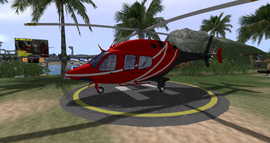The Bell 429 GlobalRanger (ICAO: B429 / WAKE: LIGHT) is a light, twin-engine helicopter. Created in Second Life by Spijkers & Wingtips and Virtual Syl Designs, the helicopter was based on the real-life Bell 429 developed by Bell Helicopter and Korea Aerospace Industries.
Background
The impetus for developing the real-life Bell 429 came primarily from the emergency medical services (EMS) industry, which had been looking for an updated helicopter to replace the Bell 427. First flight of the Bell 429 prototype took place on February 27, 2007,[1] and received type certification on July 1, 2009.[2] The aircraft has a 4-blade rotor system with soft-in-plane flex beams. The rotor blades are composite and have swept tips for reduced noise. The tail rotor is made by stacking two, two-blade rotors set at uneven intervals (to form an X) for reduced noise.[1] The combined cabin volume is 204 ft³ (5.78 m³) with a 130 ft³ passenger cabin and 74 ft³ baggage area,[3] with flat floor for patient loading. A set of rear clamshell doors under tail boom is optional for easier patient loading. The 429 has glass cockpit with 3-axis autopilot and flight director standard. Standard landing gear are skids. A retractable wheel landing gear is optional and adds 5 kt to cruising speed.[2]
Released in mid-2015, its Second Life replica was the result of a collaborative effort between S&W and Virtual Syl Designs. The mesh-modelled helicopter is powered by S&W's standard incremental collective/cyclic flight system and is equipped with internal/external lighting, animated rotors (with dust/water particle effects), opening/closing doors, optional fuel system, cargo hook, an emergency floatation system, and functioning cockpit instruments. Although not necessary for flight, the aircraft also comes with a standard S&W pilot's heads-up display (HUD). The Bell 429 is available in two separately purchasable variants - the civilian 'executive' model and an EMS/SAR version equipped with a rescue Harness, stretcher, and medical interior. Like all S&W helicopters, the aircraft is fully modifiable and is supported by several independent mod-developers.
Features
- Pilot's heads-up display (HUD) attachment with:
- Airspeed, compass, vertical horizon, RPM, vertical speed, and altitude indicators.
- Multifunctional Information Distribution System (MIDS) with region mapping.
- Main power, floats toggle, control mode toggle, FlySafe toggle, hold altitude, co-pilot control, hover mode, fuel toggle, lights toggle, combat system, search light, lock/unlock, siren, winch/cargo hook control, MIDS, and camera control switches.
- Functioning cockpit instruments with:
- Altimeter, vertical speed, airspeed, compass, artificial horizon, and fuel gauge indicators.
- Instrument lighting.
- Animated components (instruments, main rotor, tail rotor, x8 doors, and winch system).
- Realistic lighting (navigation lights, strobes, beacon, and front-facing search light).
- Emergency floatation system (optional).
- Incremental collective/cyclic flight system.
- Optional simulated fuel (DSA Fuel).
Images
References
- ↑ 1.0 1.1 "Bell Flies 429, Stretches Program". Rotor & Wing, April 2007.
- ↑ 2.0 2.1 "Bell 429 Achieves Certification". Bell Helicopter, July 1, 2009.
- ↑ "Light Twin, Big Cabin", Aviation Week & Space Technology 170, 26 (June 29, 2009), p. 42.







